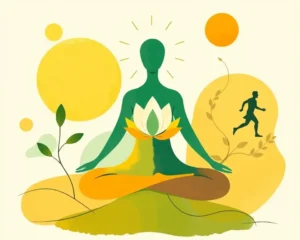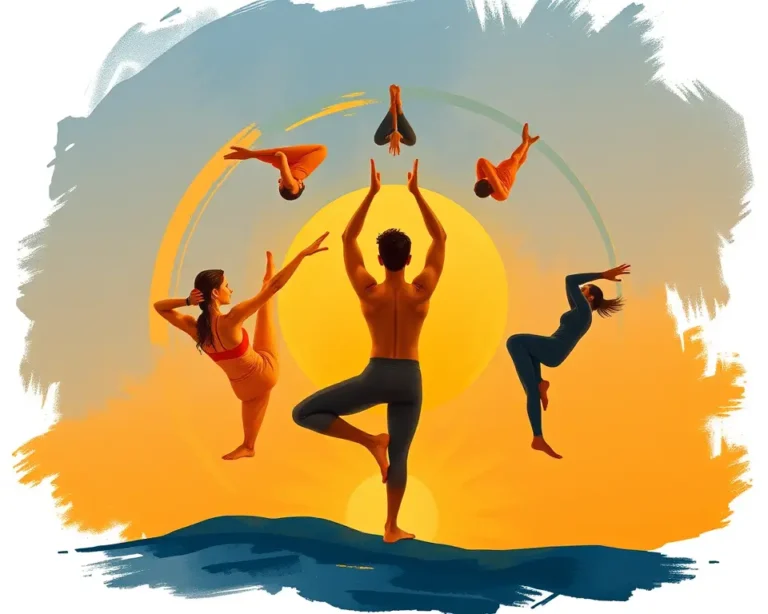Are you stuck in a fitness rut? Tired of the same old gym routine? Maybe it’s time to look to the wisdom of ancient practices. For centuries, yogis have revered Surya Namaskar, the Sun Salutation, as a complete mind-body workout. And while a few rounds are beneficial, the practice of 108 Surya Namaskars is emerging as a transformative experience that might just make you ditch the gym for good.
What are Surya Namaskars?
Surya Namaskar, also known as Sun Salutation, is a dynamic sequence of yoga postures traditionally performed to greet the sun with gratitude and reverence. The word “Surya” means “sun” in Sanskrit, and “Namaskar” means “to bow down” or “salute”. Regular practice is believed to impart the power and radiance of the sun.
Each round of Surya Namaskar consists of 12 poses that flow seamlessly from one to the next, synchronizing breath with movement. The 12 poses in a traditional Hatha Surya Namaskar are:
- Pranamasana (Prayer Pose): Standing tall with hands in prayer position at the chest.
- Hastauttanasana (Raised Arms Pose): Inhaling and raising the arms overhead, gently arching backward.
- Hastapadasana (Standing Forward Bend): Exhaling and bending forward from the hips, bringing the hands to the feet or as close as possible.
- Ashwa Sanchalanasana (Equestrian Pose): Inhaling and stepping one leg back, bending the front knee, and looking up.
- Dandasana (Stick Pose): Exhaling and bringing the other leg back to join the first, forming a straight line from head to heels.
- Ashtanga Namaskara (Eight-Limbed Pose): Lowering the knees, chest, and chin to the floor while keeping the hips raised.
- Bhujangasana (Cobra Pose): Sliding forward and raising the chest off the floor, arching the back.
- Adho Mukha Svanasana (Downward-Facing Dog): Exhaling and lifting the hips up and back, forming an inverted V-shape.
- Ashwa Sanchalanasana (Equestrian Pose): Inhaling and stepping the same leg forward that was stepped back in pose 4, bending the front knee, and looking up.
- Hastapadasana (Standing Forward Bend): Exhaling and bringing the other foot forward to join the first, bending forward from the hips.
- Hastauttanasana (Raised Arms Pose): Inhaling and raising the arms overhead, gently arching backward.
- Tadasana (Mountain Pose): Exhaling and returning to the starting position, standing tall with hands at the sides.
This sequence is then repeated, leading with the opposite leg in pose 4 and 9 to complete one full cycle.
The History of Surya Namaskar
The practice of Surya Namaskar can be traced back to ancient India and the Vedic period, where the sun was worshipped as a god and saluting it was a way to honor its power and energy. The original Surya Namaskar was not a set of yoga poses but a collection of sacred words chanted at sunrise.
Over time, the practice evolved, with the sequence of poses becoming more defined. In the 1920s, Bhavanarao Pant Pratinidhi, the Raja of Aundh, refined and popularized Surya Namaskar, introducing it to schools in his kingdom. He even wrote a book about it in 1928 called “Surya Namaskars (Sun Adoration) for Health, Efficiency and Longevity”. Swami Sivananda (1887 – 1963) played a key role in popularizing the practice in the 20th century, incorporating Surya Namaskar as a warm-up exercise for yoga asanas.
Today, Surya Namaskar is a widely practiced yoga sequence around the world, with many variations adapted to suit different levels and styles of yoga.
Why 108? The Significance of the Number
While doing a few rounds of Surya Namaskar is a great way to start your day, why do 108? The number 108 is considered sacred in various religions and traditions, including Hinduism, Buddhism, and Jainism. It holds astronomical, mathematical, and spiritual significance:
- Astronomical Significance: The distance between the Sun and Earth is approximately 108 times the Sun’s diameter.
- Ayurvedic Medicine: It is believed that there are 108 sacred points (marmas) on the human body.
- Spiritual Significance: In yogic tradition, 108 represents the whole of existence. Malas, or prayer necklaces, often have 108 beads, used to count repetitions of mantras.
Completing 108 Sun Salutations is a powerful practice that can lead to a deeper connection with oneself and the universe. It is often performed during significant events, such as solstices, equinoxes, or other transitions, as a way to honor change and new beginnings.
108 Surya Namaskars vs. Gym: The Benefits
So, why should you consider doing 108 Surya Namaskars instead of hitting the gym? Here’s a breakdown of the benefits:
- Full-Body Workout: Surya Namaskar engages all major muscle groups, including the core, arms, legs, and back. This is a more holistic approach compared to gym workouts that often isolate specific muscle groups. Each pose strengthens different muscles while improving agility, making it an all-in-one fitness routine.
- Cardiovascular Health: The dynamic sequence of movements increases the heart rate and enhances circulation, improving cardiovascular health. It strengthens the heart muscles and delivers more oxygen to vital organs. Studies have shown that fast-paced Surya Namaskar has similar effects as physical aerobic exercises.
- Flexibility and Posture: Surya Namaskar increases spinal flexibility and corrects posture. The continuous backward and forward bends keep the muscles lean and agile, preventing the danger of tight muscles leading to injuries. It relaxes stiff hips, shoulders, and hamstrings.
- Weight Management: Surya Namaskar is an excellent calorie burner. While the exact number of calories burned varies depending on the pace and intensity, studies estimate that 10-12 rounds can burn around 139 calories. Regular practice speeds up metabolism and tones muscles, which can help maintain a healthy weight.
- Mental Clarity and Emotional Balance: Deep breathing, which accompanies the Surya Namaskar postures, calms the nervous system, builds focus and discipline, and reduces anxiety. By regulating the breath and aligning movement with mindfulness, Surya Namaskar helps restore emotional balance.
- Detoxification: Surya Namaskar increases blood flow and oxygenation, promoting the removal of toxins through sweat and breath.
- Hormonal Balance: It stimulates the endocrine system, especially the adrenal, thyroid, and pituitary glands, helping regulate mood and energy levels.
- Inner Strength and Willpower: Completing 108 rounds requires commitment and mental strength, building inner resilience and self-discipline.
- Improved Sleep Quality: Surya Namaskar aids in improving sleep quality and reducing insomnia. The asanas ease tension and promote relaxation throughout the body and mind, making restful sleep easier to achieve.
- Joint-Friendly and Sustainable: Unlike intense gym workouts that can wear down joints over time, Surya Namaskar, with its controlled fluid movements, strengthens the body without straining it. This makes it a fitness practice that can be maintained well into your 60s, 70s, or beyond without risk of injury.
- Mind-Body Connection: Surya Namaskar integrates physical and mental wellness, whereas gym workouts often emphasize physical fitness and strength.
Potential Drawbacks
While the benefits of 108 Surya Namaskars are immense, it’s essential to be aware of the potential drawbacks:
- Time Commitment: Completing 108 rounds can take a significant amount of time, potentially 90 minutes to 2 hours, depending on your pace.
- Physical Demands: This practice is physically demanding and may not be suitable for everyone, especially beginners or those with certain health conditions.
- Risk of Injury: Improper form can lead to injuries, especially if you’re pushing yourself too hard.
How to Prepare for 108 Surya Namaskars
If you’re considering taking on the 108 Surya Namaskar challenge, here are some tips to prepare:
- Consult with a Healthcare Professional: If you have any underlying health conditions, such as heart problems, hypertension, or joint issues, consult with a doctor before starting this practice.
- Build a Foundation: If you’re new to Surya Namaskar, start with a smaller number of rounds and gradually increase as your strength and endurance improve.
- Learn Proper Form: It’s crucial to learn the correct alignment and technique for each pose to avoid injuries. Consider working with a qualified yoga instructor who can provide guidance and corrections.
- Listen to Your Body: Pay attention to your body’s signals and don’t push yourself beyond your limits. Rest when you need to, and modify the poses as necessary.
- Stay Hydrated: Drink plenty of water before, during, and after the practice to stay hydrated.
- Warm-Up: Before starting the 108 rounds, do a gentle warm-up to prepare your body. This could include joint rotations, stretches, and a few rounds of slow-paced Surya Namaskar.
- Set an Intention: Before you begin, take a moment to set an intention for your practice. This could be anything from improving your physical health to cultivating inner peace or expressing gratitude to the sun.
- Find a Rhythm: Experiment with different paces to find a rhythm that suits you. Some people prefer a faster pace for a more aerobic workout, while others prefer a slower pace for a more meditative experience.
- Take Breaks: Don’t feel like you have to do all 108 rounds without stopping. Take breaks as needed to rest and rehydrate. You can break the practice into smaller sets, such as 4 sets of 27 rounds.
- Cool Down: After completing the 108 rounds, take some time to cool down with gentle stretches and relaxation. Savasana (Corpse Pose) is an excellent way to end the practice.
Variations to Keep it Interesting
To avoid monotony and challenge your body in different ways, consider incorporating variations into your Surya Namaskar practice. There are numerous variations, including:
- Ashtanga Vinyasa Surya Namaskar A & B: These variations incorporate more dynamic movements and transitions.
- Half Sun Salutation (Ardha Surya Namaskar): This is a simplified version of Surya Namaskar, suitable for beginners or those with limited mobility.
- Seated Sun Salutation (Upavistha Surya Namaskar): This variation is performed while seated, making it accessible for those with physical limitations.
- Chair Sun Salutation: This variation is performed using a chair for support, making it suitable for those with mobility issues or injuries.
- Adding Warrior Poses: Incorporate Warrior I, Warrior II, and Reverse Warrior poses into the sequence for added strength and balance.
- Adding Plank Variations: Include side planks or forearm planks for increased core engagement.
- Three-Legged Downward Dog: Lift one leg towards the ceiling in Downward-Facing Dog for a deeper stretch.
- Wild Thing Pose: Transition from Downward-Facing Dog to Wild Thing Pose for a heart-opening backbend.
- Garland Pose (Malasana): Incorporate Garland Pose into the sequence for a hip-opening stretch.
Is 108 Surya Namaskars For You?
The decision to embrace 108 Surya Namaskars is a personal one. If you’re seeking a holistic approach to fitness that integrates physical, mental, and spiritual well-being, this ancient practice may be just what you need. It offers a challenging yet rewarding alternative to the gym, providing a full-body workout, improved cardiovascular health, increased flexibility, mental clarity, and a deeper connection to yourself.
However, it’s crucial to approach this practice with awareness, preparation, and respect for your body’s limitations. Start slowly, learn proper form, and listen to your body’s signals. With consistent and mindful practice, 108 Surya Namaskars can be a transformative journey towards a healthier, happier, and more balanced you.







